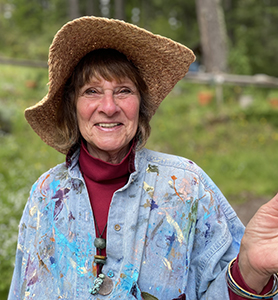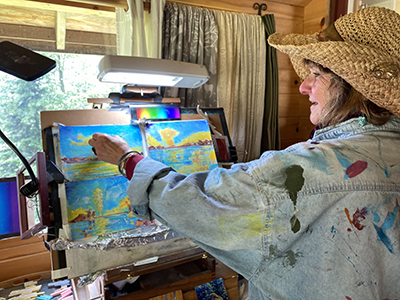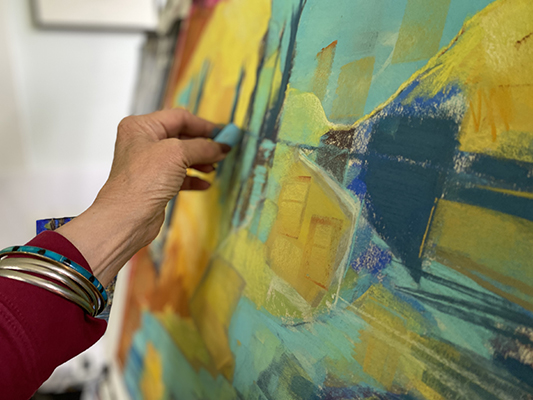||| SUN DAYS ON ORCAS BY EDEE KULPER |||

Susan Slapin
Susan Slapin lives life enamored with nature, birds singing all around, lilacs and forsythias brightening the air, vibrant choices of pastels to fit her mood, and her partner and her dog Matisse at her side. She kindly allowed me to be immersed in her life one beautiful day – a life surrounded by deep meaning, thought, and emotion captured in her paintings, etchings, prints, and monotypes in stacks of portfolios and printed in her newly published books.
What got you on fire for art?
There are two things. I was born in Connecticut and I started obsessing about color from almost the time I can remember seeing. I would do these gradations of color scales in my head and think, “White, off-white, cream, beige, eggshell, tan, yellow, khaki.” People would talk and I would be like, “I’m bored, I’m going in here (in her mind).” That’s always been my card – the visual world – nature, beauty. Being an empathic, sensory person contributed too because that’s how I understand the world. We interpret the world how we are wired.
You sound like you can be an introvert and an extrovert.
And extreme.
Have you always done art?
I’ve always, always, always done art.
At Cal State, master color theorist James Turrell was my art teacher who taught the nature of light and color. He excavated a tunnel through an extinct volcano in Flagstaff, Arizona, to study light and color – it’s really something! Roden Crater – it’s an ongoing project.
I went to a private college in Oregon called Marylhurst University. It was over a hundred years old, and I loved it. It was very spiritual. Teachers were either nuns, like my poetry teacher, Sister Helena Brand – I have her book, Orchards, Gardens, and Pieces of Sky – and then the art department was solid, like Stephen Hayes, a really well-known monoprinter, and Martha Pfanshmidt – great etchings.

So you got a lot of art training in your life?
I did. I went to San Francisco Art Institute and that was lithography, printmaking, working with the Academy of Motion Picture Arts and Sciences archiving all the black and white photos from the old films – talk about composition! That was training I didn’t even realize when I was 18. My brother Robert Slapin, who was a human rights and social justice attorney as well as a great photographer, gifted me my first Nikon camera around that time. Later, I did wedding photography for awhile. Robert Moran’s great-granddaughter’s wedding was one of the highlights, and I love photography.
I used to design wearable art. I had a shop in Ojai. I painted on different silk fabrics and designed clothes, (she shows me photos of a fashion show in Santa Barbara set to the music of Andreas Vollenweider). The clothes went down the runway, and my hearing went out. I had sensory overload. My mother said, “Did you hear people ooh-ing and aah-ing?” I said, “I didn’t hear anything.”
As an artist, is learning new things easy or hard for you?
Both. External changes are hard. Things I have to do that aren’t internally driven are hard. Things I want to work on and make better, that’s two-fold. If it’s like, “Hey, go off the island more, be in the world more, show up, do art fairs, teach a large class somewhere else,” uh uh, that’s not me. I did art fairs a long time ago in Ventura from Ojai when I did wearable art and started painting T-shirts (I’ve done silkscreen; I’ve done a lot of things.) There are two ways to answer the question. If it’s chronological, it’s always been a dance. If it’s in general, if I’m passionate about it, like when I wake up in the morning sometimes I’ll just get up and go right to the studio and I’ve got pastels in my hand because I’m driven. If it was heavier equipment or more technical, I knew that’s not my area. If it’s inner directed, intuitive, and I have a capacity to learn about it, and I really want to know about it, then I want to know about it.
Is art therapeutic for you?
N-O, N-O, N-O. It’s like asking Beethoven if music is therapy for him. I’m compelled. It’s like my veins have colors in them, and there’s fire.

Are you always wanting to do art or do you take breaks?
I stop when the egg is well-done, when I’m fried. I do it when I get moved to do it, which is almost every day. It can be any time of day. Sometimes it’s late at night, sometimes in the morning, sometimes the middle of the day, sometimes it’s twenty-five minutes, sometimes it’s four hours.
When you’re going to do a piece, do you already have it in your mind or do you just see what happens?
I see what happens. Even if I have a picture of a place, my impulse mind – I don’t even want to say intuitive, because it’s stronger – is going to override the form eventually.
When was the first time you thought, “I’d like to make a living through art?”
Well, I hardly make a living through art. That’s the truth. I’ve taught, I worked in special ed, I worked at Ojai Valley High School as an art teacher, and I’ve done improv. I love working one-to-one because, frankly, I don’t know a lot and I know a lot about the elements of art, and I always want to learn more. I study so much. I’m really analytical about my work and also intuitive.
Do you teach art the way you do it or the way “people” do it?
I teach it from a really wide pool of approaches. First of all, when I work with someone, I want to know who they are – who are you, how are you wired, how do you move, what appeals to you, what kind of range do you feel like, do you think you’re more toward watercolor or do you want heavy, massive, boulder form and a heavier material? So I work more with ‘Who are you?’ and then bring in the elements of art, and then dance between inquiry – design, composition, color.
Why did you make a book of your art?
Because I was compelled. When I was a kid I wanted to write children’s books. I told (a friend) about the book and that she could check it out at the library, and she did. She said “I need to buy this – it’s like an adult children’s book.” I thought that was great because there’s a lot in there about real feelings and the human condition. It’s spiritual, it’s a tangent, it’s about wonders, and it has a little bit of wisdom.
The other book came after that because I wanted to make a smaller edition. There were poems that weren’t in the bigger one that are in the smaller one, and some of them are really different, like “Indonesia Man.” There’s another one called “Nets and Fibers.” I like “Nets and Fibers” a lot – it’s almost like tracing a brain, or hearing a brain think. Talk about left/right brain – in studio or art work, I do the occasional plein air, which I am going to do more of, and it’s always a dance between intuition and analytical. In doing the book, the analytical muscle moved up into a deep dive of technology. There was not one more cell in there for extra.
What taught you in life how to get to the heart of how you’re feeling and be able to communicate it?
I don’t know. I wonder what taught me, what gave me the language. I wonder if it’s part of my gene pool. I could cry because I wish I was a lot better at things.
Are you judgmental of yourself?
Oh God, yeah.
What’s the worst thing about you, to you?
I’m too sensitive for most people, I’m too sometimes dramatic when I’m in my Carol-Tuttle-Type-3-‘I’m-on-a-
Carol Tuttle is a very conservative woman from the Midwest. She started studying and got personalities down to four: 1 is happy; 2 is quiet, thorough, patient; 3 is a lot of fire and wind; 4s don’t get knocked around and are more physically grounded. It helps me frame who’s who and helps me understand them a little more and be less reactive.
I just had this fun thought that there’s one big human and out of that are taken all these molecular things to make other humans, and then even within all that it’s all part of a big tree somehow. We’re not separate – how do we ever think we’re separate? Everything needs oxygen, everything wants to live, everything has a life force. I don’t know how to make sense of it anymore – and I’m certainly over twenty – but I just know there’s a whole lot that we don’t know, and anyone who thinks they know everything, I don’t really need to know them (said laughingly).
Do you do art when something bothers you in life or do you reserve it for happiness?
It’s everything. It’s analyzing, evaluating, dissecting my personal journey, the love of color, understanding where I am in the current world. I’ve never said art is therapy for me, but in the last six months I would say that my pastels are medicine. They are medicine. Sometimes life is graphic and sometimes it’s so soft.
What do you need to do before you die?
As long as I can, I want to keep living a healthy, vital, creative life. My mom lived to be over a hundred and I’m more tired than I was five years ago, but so what? The gift of creativity has infused my being. I feel the beauty in the world and I express it. I don’t get bored.
Sixty of my books are out in the world. That’s one of the things I needed to do in life. I felt grateful to participate in reading from my book, Painted Bird: painted skies and pastel poems, at the Lit Fest (June 3-4) and I’m deeply grateful for the creative gifts that I came in with.
Talking with Susan is like talking with someone in their twenties. She is youthful, fun, excited about life, and interested in feeling, experiencing, and expressing its myriad abundance. Her books are not available in stores or online, and she only has a handful left. If you would like one, contact her at susan@susanslapin.com. Susan’s work can be seen at the Waterfront Gallery at 434 Prune Alley and at her current exhibit at Banner Bank from July 5-28.
Thank you, Susan, for giving me a lovely window into your world.
**If you are reading theOrcasonian for free, thank your fellow islanders. If you would like to support theOrcasonian CLICK HERE to set your modestly-priced, voluntary subscription. Otherwise, no worries; we’re happy to share with you.**









This is a lovely article about a very talented local artist. Thank you!
Susan is a beautiful blend of Art and Heart. Love you Susan. Keep being you!
On a hillside near East Sound there is a fountain of veridian, azurite, vermillion and gold. Along with love and humor and nonsense. Without her our island would slip with a shocking whoosh into the Big Gray. Orcas Island, if you want to stay afloat, pay attention to those souls, who take so little space, who speak with such quiet truth.
To tell the truth, I admire people like Susan Slapin who radiate such a positive energy and who fall in love with their life. Such people are the best source of inspiration and you look at your life from a different angle with them. I can say that nature is a special piece of art and the best way to get aesthetic pleasure. I absolutely agree with Susan that we interpret the world how we are wired because every person has an absolutely different worldview and looks at the world in his own way, through the prism of his perception. Also, I think that we see what we emit. Actually, I can understand Susan to a great extent because sometimes it seems to me that I am hypersensitive and that I can’t imagine my life without drama, but it bothers me in some ways. It is so cool that Susan wants to keep living a healthy, vital, creative life because creativity brings colors to our life, making it truly interesting.